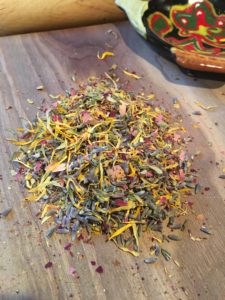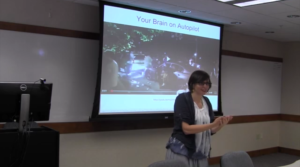The word play ritual to spell release, intention and surrender

As the year end is getting closer, people take time to reflect on the months past and set their vision for the future. Today, I offer you a ritual that can bring more creative play to this process. Words, rituals and play captivate the brain in their own unique ways and facilitate transformation. Words can cause the brain to create a vivid and real experience of whatever these words represent to us. Rituals tap into the predictive power of the brain to set expectations and rewire the brain to give commands in accordance with such expectations. Play liberates our creative spirit, silences the inner critic, and allows us to see a broader range of possibilities and solutions.
The ritual below is a form of contemplative practice, so it should not be rushed. You may have heard that the popularity of coloring books for adults have grown over the past years because they help people release stress. Coloring is easy and gives an opportunity for the mind to wander. In addition, research suggests that using your hands to write or do crafts, like knitting, for example, also benefits the brain. The word play ritual offers the same benefits but in a more personal and creative way. Children can have fun with it too.
It is inspired by nature and the change of seasons. While trees let go of the leaves and stay bare in their dreamy rest through the winter, our human cycle of activity tends to speed up during the holiday season. Amidst this hustle and bustle, it is useful to find a practice that can bring us to the roots, ground and center our energy. As leaves decompose in nature to fuel the growth of plants in the Spring, our dry plant ink will help us let go of anything that is no longer needed and cultivate the quiet intention for the transformation we want to bring into our lives.
 You begin by preparing your dry plant ink. For my ink, I used dry rose petals, chamomile flowers and lavender flowers that I often use to brew teas. Dry herbs, spices, tea leaves are all good options. You can crumble the dry plants with your hands or use a rolling pin.
You begin by preparing your dry plant ink. For my ink, I used dry rose petals, chamomile flowers and lavender flowers that I often use to brew teas. Dry herbs, spices, tea leaves are all good options. You can crumble the dry plants with your hands or use a rolling pin.
 I like to collect my dry plant ink into a mesh sachet bag. I may even through a few of my favorite crystals into the mix. When not in use, you can keep such sachet on your desk for its beautiful aroma, which will serve as another reminder to your brain of your set intentions. (The sense of smell is the only one of the five senses directly linked to the limbic system – the center of emotions in the brain.)
I like to collect my dry plant ink into a mesh sachet bag. I may even through a few of my favorite crystals into the mix. When not in use, you can keep such sachet on your desk for its beautiful aroma, which will serve as another reminder to your brain of your set intentions. (The sense of smell is the only one of the five senses directly linked to the limbic system – the center of emotions in the brain.)

For your project, you will also need a surface to work on, such as a sheet of paper or a canvas. Instead of a pen, I roll a paper cone to spread my dry plant ink on the surface. You can just use your fingers to spell the words too. I have a little paint brush and a broom to help me along.

Once you have everything ready, it is time to think of the words that represent something that you want to release. For example, I chose to spell the word “fear” as something to let go of. I “sit” with this word and the feelings it may stir in me as I spell it with my dry plant ink. As you paint your word, notice what comes up for you in the process. For example, I noticed that I wanted to rush and finish the “unpleasant” word faster. This is not surprising because we want to avoid unpleasant feelings or discomfort associated with them. However, I chose to slow down and make it beautiful nonetheless. Those negative feelings are there for us to warn or alert us to something. They are worthy to be acknowledges and accepted for what they are.

Once the word is completed, take time to appreciate it before you let it go. I sweep it with my tiny broom. You can mix it up with your hands or even blow it away. This represents the impermanent nature of our emotions. We can move from one mental state to another.

Now is the time to pick up a new positive word that represents something you want to focus on or bring more of into your life. You use the same dry plant ink to transform the negative into the positive as you invite the lessons of your negative experience to fuel the positive change. Savor the time and the process as you spell your positive word. Notice what comes up for you now. My positive word ended up much bigger and fuller than my negative word. I added more ink to complete it. Keep it as long as you wish before you feel it is time to return it back into the sachet bag and breathe in its lingering aroma. I left mine on my daughter’s desk for now as a surprise when she comes back from school. Perhaps, it will inspire her to paint her own.

Try it and let me know how it goes. Maybe, you will want to share your picture too.
I wish you a happy and peaceful holiday season!
[UPDATE] This is what I got back from my daughter 🙂



 Words of all kinds traverse our meadows…
Words of all kinds traverse our meadows… As a long-time student of yoga, I have come to appreciate the quiet helper that is there for us in a variety of situations if we care to notice – our own breath. We often take it for granted, but if we learn to pay attention to it and work with it consciously, it can help us regulate stress, boost confidence and increase impact of our speech.
As a long-time student of yoga, I have come to appreciate the quiet helper that is there for us in a variety of situations if we care to notice – our own breath. We often take it for granted, but if we learn to pay attention to it and work with it consciously, it can help us regulate stress, boost confidence and increase impact of our speech.